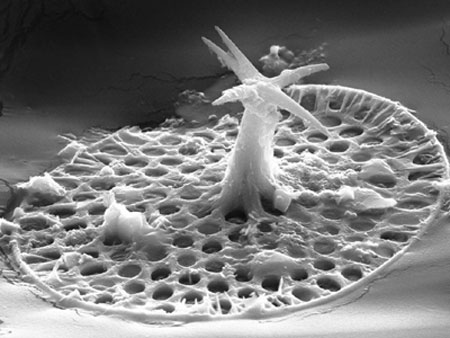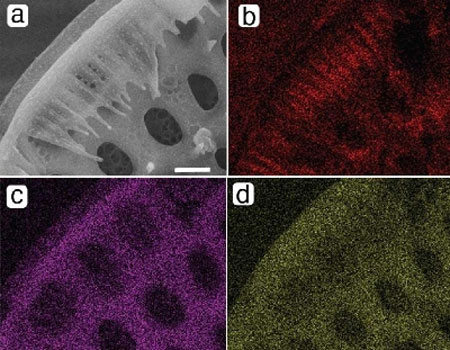Detecting fossil creatures with 700 million year old spines
Biological archaeologists from Harvard University (USA) have discovered a thorny fossil of about 700 million years old at the Alaska - Canada border - information published in The Journal Geology on 8 - 6 for know.

Images of creatures with spikes through microelectronic scanners.
According to experts, this spiny creature is a creature of the genus Characodictyon that lived at the time of the Snow Globe, 717 - 812 million years ago. At this time, unicellular organisms thrive and can then be "submerged" under the frost.
Cohen and Macdonald and the heaps at the University of California , USA (UCLA) captured the 3D image of this fossil. The images clearly show creatures that are structured in arrays like a plate, each with 20 micro-widths, equal to one-fifth of the diameter of hair fear. It is arranged in a honeycomb pattern, has many colors and has protruding spikes.

3D images of spiny creatures.
According to the analysis, the spines surrounding the body help the organism to digest and release the waste, as well as act as a "body armor" to protect the body. This is one of the earliest omnivores that has a positive impact on the development of protozoan.
Researchers are continuing to explore and hope to discover many other ancient organisms that prove the development of the ancient biological world.
- British scientists reproduce ancient creatures more than 500 million years
- Detection of fossil organisms 500 million years old
- Find jewels in a 100 million year old son
- 185 million year fossils of ancient organisms have 38 children
- Germany: Detecting 3 million-year-old fossil remains red
- Marvel at the remains of strange creatures with human legs and gibbon arms
- The 250 million year old fossil of crocodile ancestors
- 7-year-old baby 'excavated' was fossil 65 million years
- The boy took two years to restore the 200 million-year-old dragonhead fossil
- Biological fossil discovery 545 million years ago
- The animal with 50 living parts 550 million years ago could decipher the secret of life
- Fossil turtle 33 million years of rare value worth more than 4,000 USD
 Discovered an ancient centipede fossil 99 million years old
Discovered an ancient centipede fossil 99 million years old Discovered bat-like dinosaurs in China
Discovered bat-like dinosaurs in China Discovered a 200-year-old bronze cannon of the coast
Discovered a 200-year-old bronze cannon of the coast Discover 305 million-year-old spider fossils
Discover 305 million-year-old spider fossils